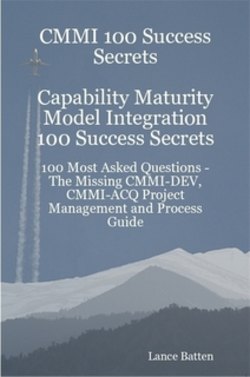Читать книгу CMMI 100 Success Secrets Capability Maturity Model Integration 100 Success Secrets - 100 Most Asked Questions: The Missing CMMI-DEV, CMMI-ACQ Project Management and Process Guide - Lance Batten - Страница 14
На сайте Литреса книга снята с продажи.
ОглавлениеThe Evolution of the CMM
In the late 80s, the American Software Engineering Institute (SEI) in cooperation with Mitre Corporation developed an architectural model that will aid the US federal government on evaluating objectively software providers proposals in managing the US government large projects. This architectural model is known as the Capability Maturity Model (CMM).
CMM is a model that represents the process maturity for software development. The advanced model shows the progress of a companyOs abilities to develop software. When companies seek the services of software developers it is necessary that they know as to when the deliverables can be served. Yet many companies complete their projects, it showed that there were significant overruns in terms of schedule and budget. With the CMM, such problems were solved.
The main concept of the CMM standard is the organizational maturity. A company is considered as a mature organization if it has clearly defined procedures as to how their software is developed and procedures in terms of project management. As software companies expand, these procedures need to be adjusted and perfected as needed.
CMM is the standard followed by software development
company in the process of development, testing, and software application; and rules for appearance of final program code, components, interfaces, etc.
The evolution of the CMM made a major milestone in the management of software process. It was at that point where the software community had a full descriptive understanding how software companies "mature" or improve, in their ability to develop software.
21
To Be on CMM Level 5
The Capability Maturity Model (CMM) is a standard guide for software developers in the development and refinement of an organization's processes. The CMM has 5 levels of maturity.
These are Level 1 (Initial), Level 2 (Repeatable), Level 3 (Defined), Level 4 (Managed) and Level 5 (Optimizing). A mature
organization depends on its capability of providing the software development at a specified time. The CMM can be considered as a benchmark used for assessing different organizations for equivalent comparison.
If your organization falls under the CMM level 5, you have achieved the highest level of maturity and your organization focus is on continuous process improvement based on quantitative feedback and pilot of new ideas and technologies. There are software project teams created by organizations to analyze the defects and determine their causes. The team evaluates to prevent the recurrence of known defects and the lessons acquired are shared to other projects. At CMM level 5, the word waste is unacceptable. Teams should organized efforts in removing the waste, without necessarily changing the entire system.
Improvement is brought about by any incremental advancement in the existing process and by innovations with new
technologies and methods. Technology and process improvements should be planned and managed as regular business
activities. CMM level 5 are audited and reviewed. A result of the rating is published by the software organization. Most organization uses this result for marketing purpose of drawing more customers and for customers to rely on their software.
Aim high, aim for CMM level 5. It may be your ticket entry into the global software development-sourcing arena.
22
